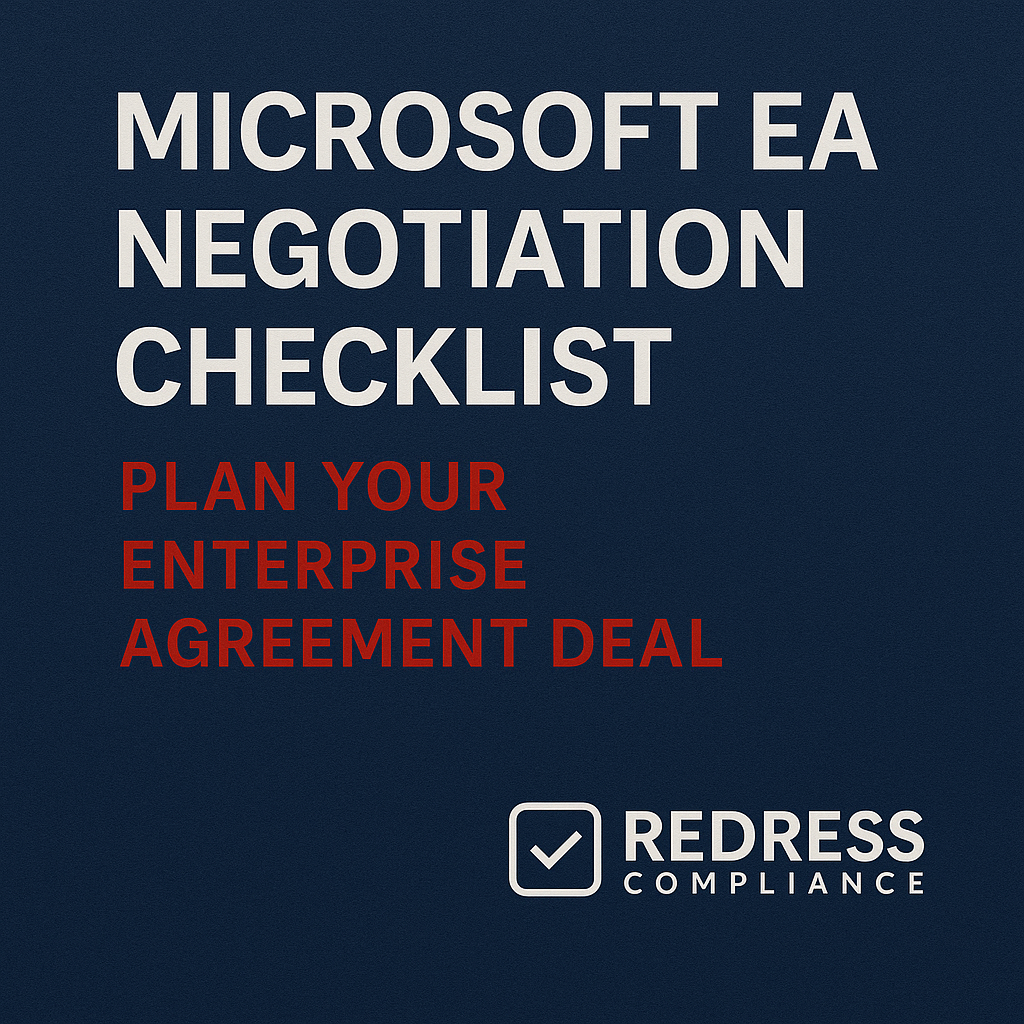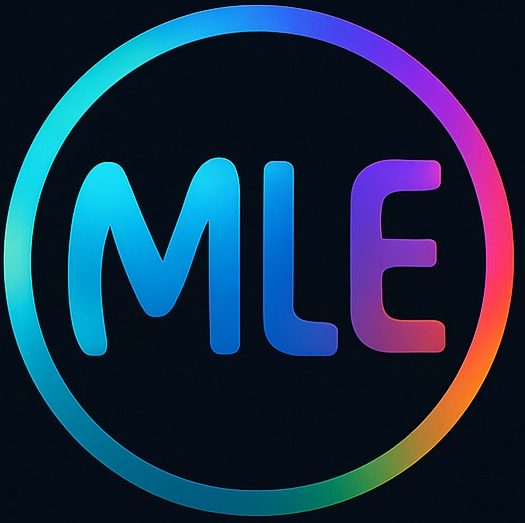Microsoft EA Negotiation Checklist: Plan Your Enterprise Agreement Deal

Introduction – Why Use an EA Negotiation Checklist
Negotiating a Microsoft Enterprise Agreement (EA) is a high-stakes process. An EA locks in your organization’s software and cloud spend for years, so oversights can cost millions or leave you stuck with inflexible terms.
That’s why a structured EA negotiation checklist is essential. It ensures your team covers all bases – from early license inventory to final contract review – and keeps you in control of leverage, flexibility, and cost. Read our Microsoft Enterprise Agreement Negotiation Guide.
This tailored enterprise agreement negotiation template provides a step-by-step plan for EA negotiation. Use it to track progress and avoid pitfalls at every stage, from early preparation through proposal analysis, active negotiations, and final contract review.
The result is a stronger negotiating position that puts your organization’s needs first, avoiding vendor lock-in tactics and maximizing value.
Pre-Negotiation Planning (EA Negotiation Plan)
- ☐ Inventory current licenses and usage (on-prem and cloud). Catalog all your existing Microsoft licenses and measure their actual usage so you know what’s being utilized and what isn’t.
- ☐ Review current EA products; cut what’s no longer needed. Remove any products or services in your EA that aren’t used or needed to eliminate unnecessary spending.
- ☐ Define your 3-year IT and business roadmap needs. Outline the projects, growth, and new technology needs you anticipate over the next three years to align your EA with actual requirements.
- ☐ Set budget thresholds for EA renewal. Establish a target budget or cost ceiling for the new EA so you can evaluate Microsoft’s proposals against a defined financial goal.
- ☐ Research external benchmarks for EA pricing. Find out what discounts and pricing peer companies of similar size get from Microsoft to gauge how competitive your offer is and where to push for more.
- ☐ Build a cross-functional negotiation team. Form a team with IT, procurement, finance, and legal representatives (plus an executive sponsor) to cover all angles and present a united front to Microsoft.
- ☐ Schedule a kickoff meeting with Microsoft. Start discussions early by meeting with Microsoft’s team to set expectations and a timeline. Show that you have a structured plan, but avoid revealing your budget or bottom line too soon.
Proposal Analysis (Enterprise Agreement Negotiation Template)
- ☐ Request Microsoft’s first proposal/quote. Ask Microsoft to provide an initial, detailed quote for the EA renewal (itemized by product and service) as a baseline for analysis.
- ☐ Break down pricing by product and discounts. Analyze Microsoft’s quote line by line. Note each product’s unit price and any applied discount, and compare them against your expectations and benchmarks.
- ☐ Identify high-cost or non-discounted items. Flag any products in the quote that are especially costly or show no significant discount – these are prime targets to negotiate down or remove.
- ☐ Verify only needed products are included. Check that the proposal doesn’t contain extras or upgrades you didn’t ask for. Ensure every item aligns with a genuine need (no blanket E5 licenses for all if not required).
- ☐ Flag any concerning contract terms. Review the quote for problematic terms or assumptions (e.g., mandatory minimum spends, auto-renew clauses, stiff payment terms) that you’ll need to negotiate to protect your interests.
Read Microsoft EA Discounts – How to Negotiate the Best Deal in 2025.
Negotiation Phase: Pricing Checklist
- ☐ Build a data-driven counteroffer. Prepare a counter-proposal with your desired pricing and discounts for each component, backed by your usage data and market research, to send a clear message of what you consider a fair deal.
- ☐ Use bundling strategically for leverage. Consider offering to include additional products or higher volumes only if it earns you substantially better discounts overall. Don’t agree to bundle anything that isn’t valuable to you.
- ☐ Optimize your license mix (right-size E3 vs E5). Avoid automatically giving everyone the most expensive license tier. Provide premium licenses (like E5) only to users who truly need them, and assign cheaper licenses (like E3) to others to save costs.
- ☐ Align any Azure commit with actual needs. If Microsoft requests an Azure spending commitment, base it strictly on your realistic projected usage. It’s wiser to commit cautiously (and add later if needed) than to overcommit and pay for unused cloud resources.
- ☐ Secure price protections for the term. Negotiate limits on price increases – ideally, lock prices for all three years or cap any annual uptick. Also, ensure that any mid-term license additions will honor the same discount rates you negotiated.
- ☐ Ask for training credits and other extras. Beyond pricing, request add-ons like training vouchers for your staff, deployment or consulting credits, or enhanced support. These extras add value to your EA and can often be obtained if you ask during negotiations.
Negotiation Phase: Terms and Protections
- ☐ Negotiate true-up and true-down flexibility. Push for the ability to decrease license counts (true-down) during the EA term if your workforce or usage shrinks. This flexibility ensures you’re not paying for unused licenses until the next renewal.
- ☐ Revise the audit clause for fairness. Add provisions that Microsoft must give advance notice (e.g. 30 days) before any audit and allow you a period to resolve compliance issues. This prevents surprise audits and gives you a chance to fix problems before penalties.
- ☐ Prevent any automatic renewal. Ensure the EA will not auto-renew on the same terms. You want the contract to end unless a new agreement is negotiated, keeping leverage on your side for the next renewal.
- ☐ Secure M&A license flexibility. Include terms that allow you to transfer or adjust licenses if your company merges, acquires another, or divests a division. You shouldn’t be penalized or stuck with excess licenses due to corporate changes.
- ☐ Negotiate a favorable payment schedule. Propose a payment plan that suits your budgeting needs (e.g. annual payments aligned with your fiscal year or semi-annual installments) instead of the default lump-sum billing, to ease cash flow.
- ☐ Align support contracts with the EA. If you have a Microsoft support agreement, arrange for it to co-terminate with your EA and ensure its cost scales with your licensing. That way, any reduction in licenses also reduces support fees, preserving your savings.
Section 5 – Final Checks Before Signing
- ☐ Cross-check final pricing and SKUs. Before signing, cross-reference the final contract with your negotiated agreement. Every product, SKU, license count, and price should match what you approved – no hidden additions or price changes.
- ☐ Make sure negotiated terms are in writing. Verify that all special terms you negotiated (discounts, caps, true-down rights, payment terms, etc.) appear in the contract or its amendments. Verbal promises are not enforceable – get everything in the written agreement.
- ☐ Verify license counts and product mix. Double-check that the final contract reflects the correct number of each license type and the agreed product mix. There should be nothing extra and nothing missing compared to what you negotiated, including any Azure commitment amounts.
- ☐ Time the EA renewal to your advantage. If possible, adjust the EA’s end date to align with strategic timing – for example, your fiscal year or Microsoft’s end-of-quarter/year when they may be more generous. Good timing can improve your negotiation leverage and budget planning.
- ☐ Hold a post-signing kickoff meeting. After signing the EA, gather your internal stakeholders (IT, finance, procurement, etc.) to review the contract details, new license provisions, and compliance obligations. Ensure everyone understands the deal and how to maximize its value and stay in compliance in the future.
FAQ – EA Negotiation Checklist in Practice
Q1: When should I start preparing my EA negotiation plan?
A: Begin preparing 12–18 months before your EA expiration. Early planning gives you time to audit usage, set goals, and build a negotiation strategy. Starting well in advance ensures you’re not rushed and can fully leverage your options.
Q2: What’s the most overlooked step in EA negotiations?
A: One commonly overlooked step is thoroughly inventorying and cutting unused licenses beforehand. Many organizations skip this and end up renewing “shelfware.” Also, failing to benchmark market pricing is a mistake – without it, you might accept a subpar discount.
Q3: How do I ensure Microsoft includes negotiated terms in the contract?
A: Get everything in writing. After negotiations, carefully review the contract and make sure all special terms (discounts, flexibilities, clauses) are explicitly documented. If something you negotiated isn’t in the contract wording, have Microsoft add it before signing.
Q4: Should CIOs or procurement lead the EA negotiation checklist process?
A: Ideally, it’s a cross-functional effort. Procurement usually leads the commercial discussions, but CIOs and IT provide critical input on needs and usage. Both should collaborate – procurement drives the process, and the CIO (or another executive sponsor) guides strategy and ensures alignment with IT goals.
Q5: Can this checklist be used for renewals as well as new EAs?
A: Yes. The checklist applies to both EA renewals and brand-new EAs. For a new EA, you may not have an existing agreement to review, but you should still inventory your needs and plan the negotiation similarly. In both cases, the steps – preparation, proposal analysis, negotiation on pricing and terms, and final checks – are fundamentally the same to secure the best deal.
Read about our Microsoft Negotiation Services
